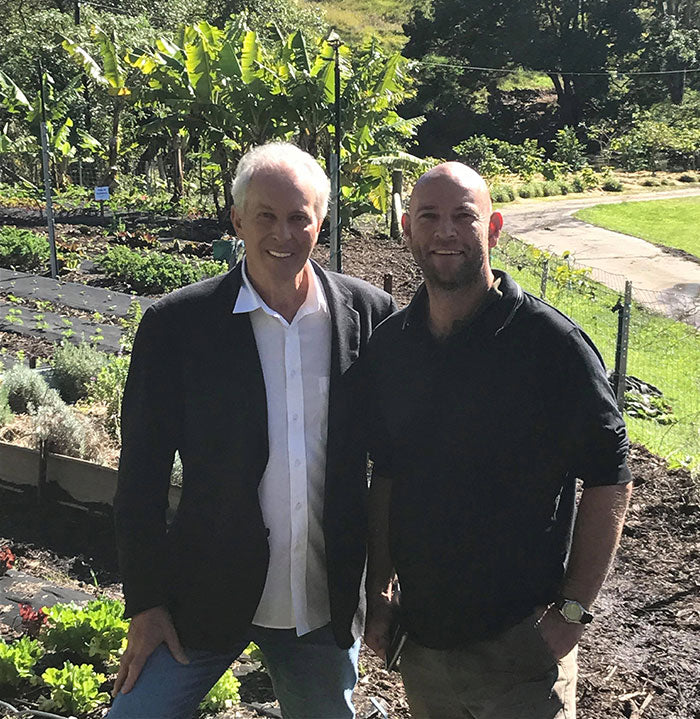Insights and Lessons Learned – Robert Craig Interviews Graeme Sait (Part 1)
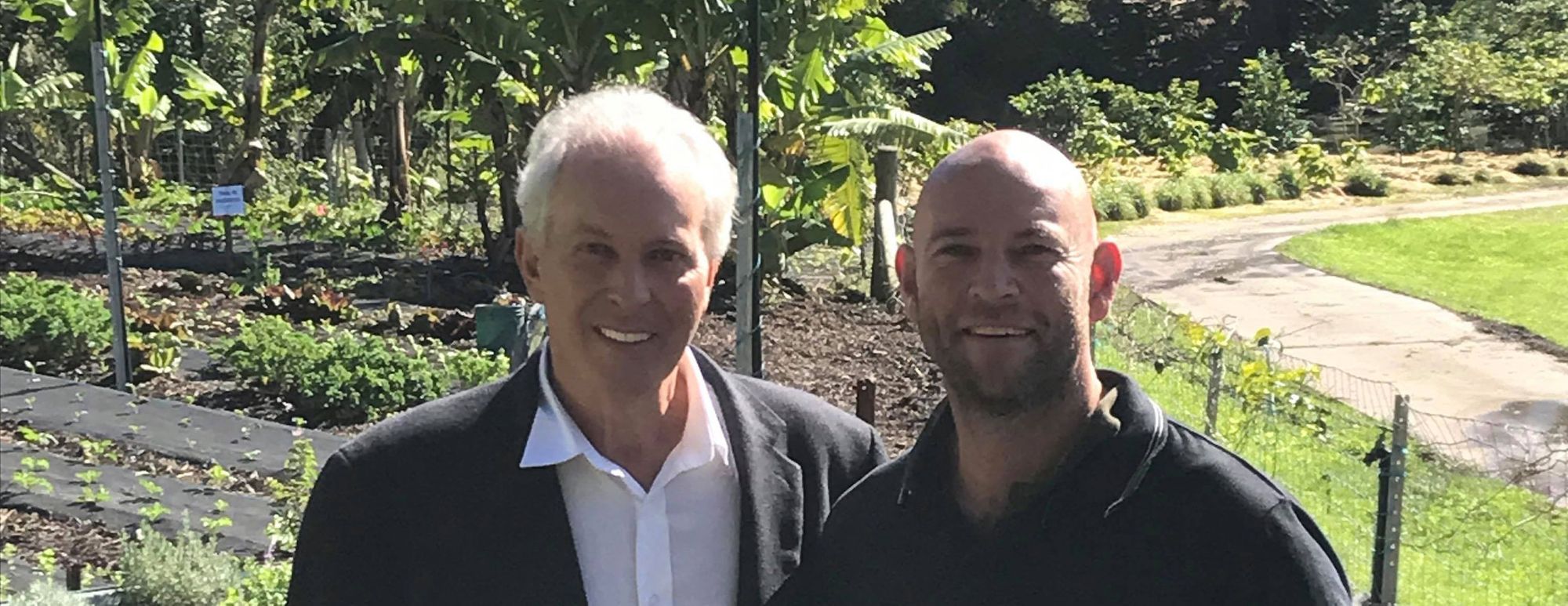
Robert Craig is a fine farmer and a close friend. His organisational skills and engineering prowess have been of immense value in multiple projects on both farms. In recent weeks, he has been spending weekends at the Nutrition Farms, Sunshine Coast property, to help fast-track a series of new initiatives.
He arrives each weekend replete with nutrient-dense treats from his own farm and we feast each evening on the fruit of our combined labors.
The conversation flows free and fast and one evening recently, Rob suggested that he had enjoyed my many interviews over the years and he felt there would be value in a role reversal, where I fielded the questions.
An interview series began that evening and will continue, from time to time, whenever we both feel inclined.
Here is part one of that series.
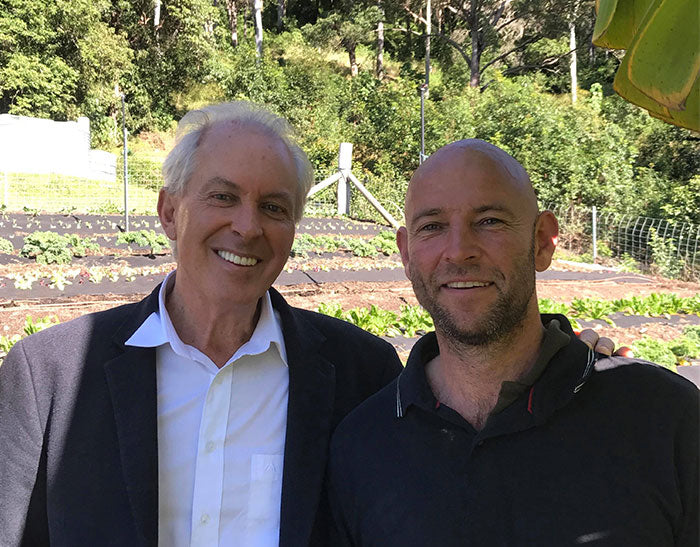
Rob: What motivates you to continue to share your message around the world at such break-neck pace? You are certainly one of the most driven souls I have encountered.
Graeme: It takes one to know one, my friend. At least I know to stop work at sunset!! Your freakish night vision capacity is not something I have seen before. I never seem to lose any of my passion. I remain driven by an overwhelming desire to help farmers become more profitable and more sustainable. When I recognised that this could be achieved, while also helping to counter climate change, the urgency of my sharing ratcheted up a couple more notches.
Farmers are my absolute favourite people. In fact, they may be the very last “real” people remaining. When I am in the cities, I count the days until I can escape the shallow, urban profit motive and return to the genuine.
Rob: You have become a serious farmer yourself in recent years. How are you finding life in the “real” world?
Graeme: It is certainly a reality check. I never really anticipated the cost of setting up two farms from scratch. I have been lucky to have support from my company, so I truly admire those whom must go it alone. It has certainly given me more empathy towards my fellow farmers and their struggles.
It is such a privilege to work with the land, but it can be such a battle to achieve profitability with so many outlays. For many, it simply becomes a labour of love. Consumers are lucky that most farmers continue to produce, while barely breaking even, but this has to change. Food prices are at their lowest ever and we still clamour for cheap milk, while our dairy farmers are decimated.
Personally, I am finding absolute joy in farming. In fact, if had my choice, I would love to spend most of my time on the farms. However, the need for global change is becoming increasingly urgent and, while I feel I am making a meaningful difference in the world, I feel obliged to continue my crusade.
Rob: What is the goal of your Nutrition Farms project?
Graeme: As you know, I am developing a sub tropical research/demonstration farm here on the Sunshine Coast and another farm up at Stanthorpe (to provide a temperate example of Nutrition Farming). I am intent upon demonstrating the viability of multiple, diverse, interrelated enterprises. It has almost reached a point where the dominant mantra of “get bigger or get out” is being slowly replaced with a new decree, “diversify or get out”. I intend to develop as many as 50 enterprises on each farm. It is ridiculously good fun!
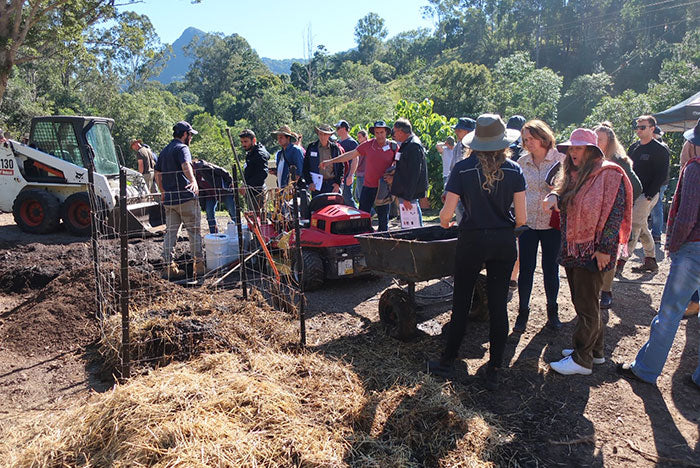
Rob: Have you identified key strategies for boosting profitability? If new generations of food producers are to embrace the farming profession, they must have a promise of profitability, beyond the “green change” idealism.
Graeme: The absolute key is to become a price maker rather than a price taker. You can’t be accepting commodity prices when you are championing quality rather than quantity. “Price making” involves four things. Number one, is your selection of crop. Number two is your management of inputs, including wages. The third, and perhaps the most important factor involves the concept of value adding. Finally, the successful marketing of your produce is a huge consideration.
Rob: Let’s deal with each of these separately. What crop choices increase your business resilience and profitability?
Graeme: I know you are a big proponent of maximising yield and profitability, on a square metre basis, in your intensive market garden model. You have shared that salad greens are the most profitable because of their short turnaround and density, and you are utilising a “smart” harvesting technology that dramatically cuts labour costs. However, while this could form part of a productive crop mix, I prefer to weight that chosen crop mix in favor of high dollar value crops and preferably those with long shelf-life and multiple income streams. Crops like ginger, turmeric and garlic are relatively easy to grow biologically, you have several months to sell them and they are extremely bountiful and profitable. It is possible to produce 80 tonnes of biological ginger, per hectare, for example. At $10 (AUD) per kg, that’s a nice solid income stream for just one of many crops.
Rob: How do we improve input management and labour efficiency?
Graeme: You are probably better equipped to answer this, because you do it so well. You are making your own biodiesel for 60 cents a litre, maximising utilisation of free council mulch, utilising volunteer labour, optimising workplace efficiency, producing your own seedlings and brewing your own living fertilisers. It is this kind of attention to detail that can seriously impact profitability.
I have the luxury of owning my own biological fertiliser factory but we are utilising many on-farm inputs. The goal of this approach is to continually reduce your requirement for outside inputs. The more you can achieve this, the more profitable you become. The biggest problem I see out there is a tendency to equate yield with profitability, when, in fact, the cost of production is the greatest guideline as to relative profitability. That’s what builds your bank account. NZ dairy farmers, for example, are obsessed with who can produce the highest kilograms of butterfat or milk solids per hectare. They pump in huge fertiliser inputs, generate nutrient imbalances, pollute the waterways, finance ever-increasing vet bills, and call that success. Most of them would be more “profitable” with less cows, managed much more efficiently.
At Nutrition Farms, we are on-farm composting and cover cropping, we fertigate the worm juice from our own worm farms, we grow out much of what we use with an on-farm commercial greenhouse, we have both a volunteer labour component and we are developing a mentoring system. We also make our own lacto-fermented, multi-purpose herbal brews utilising plants and “weeds” from the farm.
Rob: Simple strategies like preparing for the next morning, the night before, can increase labour efficiency. The farm staff should be able to begin productive work two minutes after they arrive at work, if everything is in place. Better logistics management with the purchase of all inputs, and better protection of that investment, are all part of the equation. We are both using weed gunnel to reduce weeding costs, but if you cover the gunnel with free council mulch, you slow the biodegradation and treble the lifespan of that input.
Let’s talk about your third concept, the idea of value adding, and perhaps you could also expand upon the related concept of seeking crops with multiple income streams.
Graeme: Yes. Papaya is a fine example of a crop with multiple income streams. In fact, they have seven different income flows. For a start, you can achieve two crops in the first year. You don’t have to wait five years like many orchard crops.The leaf is in demand for cancer preparations and cosmetics, and the green fruit fetches higher premiums than the ripe fruit in a shorter time. Green papaya salad can be a value added creation for sales to restaurants and the public. They just need to understand that the green fruit contains 40 times more of the powerhouse protein digesting enzyme, papain, when compared to the ripe fruit. When consumed with protein, this reduces drawdown on your own limited bank account of protease. Marketing always involves a story that generates a demand.
The ripe papaya can achieve $5 per kg and there can be over 30 fruit per fruiting, per plant. We have a couple of commercial dehydrators and there is great demand for this sweet dried treat, so that’s five income streams.
There can be several hundred seeds in a large, ripe papaya and each one can produce a seedling, that can be sold at the farmers markets for $3 each.
Finally, the dried seeds are strongly anti-parasitic for humans and livestock, and can be sold as a paw paw pepper. That’s seven income streams from a single crop!
Value adding can include drying, fermenting and pickling excess product. It can involve creation of DIY cosmetics, snacks, herbal preparations, teas, essential oils and fermented drinks. We make a wonderful freeze-dried, turmeric powder, infused with organic pepper. This popular anti-inflammatory powerhouse is marketed as Curcu-Life, under the Nutrition Farms logo and label.

Rob: Curcu-Life is certainly very special. I love the fresh intensive smell of the organic turmeric. It is so vastly different from imported powders, which are irradiated and denatured upon entry to Australia.
Now let’s discuss marketing. You can produce the best food in the world. But there is not much point if you haven’t learnt how to sell it. Can you provide some pointers that can help more of us become “price makers”?
Graeme: I would love to. You are correct in that it is often the missing link. The key here, whenever possible, is to create a market and grow specifically for that market. If you can produce exceptional sweet corn, for example, then find a buyer and commit to producing 200 cobs per week, every week for 8 months, that’s a guaranteed income stream of $200 per week from one small crop but it involves organisation and timing to ensure that you will always deliver.
Social media is the most effective marketing tool and it takes traditional word of mouth advertising to a new level. Advertise your farm shop, or CSA boxes on line and scream your attributes out loud. If you are growing garlic with our Triple Ten™, for example, then that garlic will have at least twice the selenium component of any other garlic, and you need to be sharing this enhanced medicinal feature, unique to your crop. A website is essential and a regular blog will keep you in the minds of customers.
The rise and rise of Farmers’ Markets are an example of a global phenomenon, where consumers are increasingly intent upon “putting a face to their food”. The fact that almost every stand features a burgeoning component of “spray free” options, reflects the fact that people would prefer that “face” to be practicing regenerative farming.
Rob: I understand you were not always the confident speaker. You were forced to become the educator for NTS, because you had the most in-depth understanding of regenerative principles. Was it a struggle conquering your fears?
Graeme: It was an interesting start. I had an all-consuming fear of public speaking, to the point that I would rather be in the coffin than speak at a funeral. Before each dreaded presentation, I would take along a hip flask of brandy and pour it back. Then I would eat some peppermints to mask the smell, so my hosts wouldn’t think I was an alcoholic. After six months of that, I realised I would be one if I continued, so I ditched the Dutch courage. For the next couple of years, the fear was so intense, I vomited before I spoke. It took several years before it became manageable and then another few years until I actually started to enjoy it. Now, I am in love with teaching. It feels like my greatest achievement, to have turned my greatest fear into my greatest passion.
Rob: Your journey in regenerative agriculture began 25 years ago. I imagine you have experienced some resistance to your teachings, particularly in the early days. Have you noticed a change in receptivity amongst farmers over the years?
Graeme: What started as a trickle of interest has become a raging river. All of us working in this field have noted the dramatic turnaround. In fact, I think it is fair to describe this scale of change as an emerging revolution. I teach in many countries each year and farmers and consultants everywhere are recognising the need for change, and exploring regenerative principles. There are still some old school chemical consultants clinging to their mistakes and condemning the new strategies and inputs. I guess it is hard to acknowledge that you have been misguided all of these years, so you must now desperately rationalise your poor advice and cling to your misconceptions. I call it “the screams of the dinosaurs”.
There are several drivers of this revolution including climate change, serious topsoil losses, growing public concern about fresh food quality and environmental contamination, and the loss of soil fertility. Then, there is the insect Armageddon, where we are losing the biggest players in the web of life at an alarming rate. It is not just colony collapse with our bees, it is all flying insects that are in crisis. It appears the neonicotinoids have done their job too well. In our region, during the past couple of seasons, there were no Christmas beetles or flying ant invasions in summer. The windscreen test is another wake up call. I can now make the four-hour drive to my second farm and not once need to wash the windscreen. Just five years back, the splat factor obscured vision, every hour on the road.
Rob: What about the academics and scientists? Has their interest increased?
Graeme: Yes, most certainly. My courses around the world are increasingly attended by professors and agricultural scientists. In fact, during my last visit to India, there were 45 professors at one two-day course. In the UK last December, my tour of Cornwall was sponsored by a group of universities. Integrative medical doctors regularly attend, as they awaken to the links between soil health and human health. This was rarely the case a couple of decades back. I guess it suggests that the many problems are becoming more obvious now.
Rob: You teach about the urgent need for climate change action, and your understanding of this issue may be more informed than most. Do you ever get despondent in the face of an avalanche of frightening findings? Do you sometimes feel like giving up the fight, halting the global travel and just enjoying life?
Graeme: There is a very real possibility that we may not be here in 20 years time, if we don’t stop the slide. At this point, I still think we can reverse some of the damage, but we do need to address our apathy. Many of us remain more concerned about who kicked which ball through what goal, than the undeniable evidence of our gross mismanagement of our planet. What we do in the next few years will totally determine our future viability, and there is no place for apathy.
From a personal perspective, I try to stay positive. I still sincerely believe that the soil can save us and I am doing everything in my power to inspire farmers, gardeners and politicians to embrace necessary change. My mission is not a sacrifice. I meet the most amazing people everywhere and they constantly inspire me. The people involved in regenerative agriculture are beyond words. I guess I live life through rose-coloured glasses. I am sure that arsehole farmers exist, but I never get to meet them.
Rob: You have often discussed the likelihood of a complete economic crash. Sometimes, it almost feels like you welcome this global disaster. How can you be positive about the potential of mass material loss, 60% unemployment, and social chaos? How could this horror show have a silver lining?
Graeme: There are two parts to this answer. The first involves the increasing likelihood of a climate change calamity that may well threaten our very survival. Two of the major drivers of the gases that thicken the blanket, trap the heat, warm our oceans and dramatically change our climate, would be hugely impacted in a depression. I am talking about the two largest contributors of CO2, coal fired power stations and concrete production. Concrete making involves the burning of calcium carbonate to make calcium oxide, with the associated release of CO2 to the atmosphere. In a global depression, projects are put on hold, and concrete production dwindles dramatically. Similarly, the need for energy production falls when industry declines. It would certainly be traumatic for everyone, but a depression might also give us the breathing space to sort some solutions.
The second part to this response involves the need to hit the reset button. A depression might see us re-evaluating our path forward. We have bought into a materialist, consumerism model where we could now be fairly described as “eating from the bones of a dying planet”. The meaning of life centres around the amount of peace and happiness we achieve in our allotted time. The opposite to peace and happiness is fear and anxiety. We are a terribly fearful people. In fact, fear is the driver of most of our major institutions, including our Governments. We can’t even justify our rape and plundering by stating that it brought us more peace and happiness, because it brought us the opposite. There are many people seeking a move away from blind materialism towards something more meaningful. Perhaps a greater emphasis upon community, regeneration and sharing – a move away from fear in favour of love.
Rob: You have often mentioned that there can be tremendous opportunities within the regenerative space, and that a good Government should be recognising these opportunities and embracing them. Can you provide a couple of examples of how we could move forward more productively and more sustainably?
Graeme: Yes, certainly. There is a shocking lack of entrepreneurial initiative at Government level. We just seem to blunder down the same path, pursuing the same mistakes and dancing to the same puppet masters. I will give you an example of a huge opportunity that would boost our rural sector, our economy, our international reputation and our sustainability. I am talking about the opportunity surrounding large scale hemp production. Hemp could easily replace some of our major crops, like sugar cane, for example, but it would require some Government support in establishing processing plants and value-adding initiatives. Let me give you seven reasons why this is worthy of consideration.
-
Dioxins are one of the most serious environmental pollutants. This class one carcinogen is now found throughout our food chain. Dioxins, yet another gift to the world from the Monsanto Corporation, are fat soluble, so they accumulate in animal fats like milk and butter and essential fats, like those in fish oil. The breast milk from Inuit mothers, for example, was found to qualify as a hazardous waste, under EPA standards. It was heavily laced with dioxins from their high fat diet, involving seals and other mammals. The largest source of dioxins poisoning our environment comes from paper making. Bleach is a primary dioxin and softwood pulp is bleached to create the millions of tonnes of paper we consume each month. Commercial softwood forests take twenty years to produce the exact same amount of paper we could produce in just four months with industrial hemp. Do the sums and you will see that this is actually a 60-fold increase in efficiency. However, there is something more important involved here. Hemp is bleached with hydrogen peroxide (H2O2), a natural substance, that equates to a form of liquid oxygen. It seems a no brainer – we produce the same amount of paper in one sixtieth of the time, and we stop pouring dioxins into our environment. The paper quality is also vastly superior. In fact, many ancient documents that still exist today, were printed on hemp parchment. The Magna Carta, which is over 800 years old, is just one example.
-
Hempcrete is made from calcium carbonate combined with hemp fiber. Unlike concrete, there is no burning of limestone involved. It can be produced in-situ or entire walls can be pre-constructed and locked together to create dwellings. This remarkable building material is more insulating than straw bale or mud brick construction and it is completely fireproof. It is the obvious direction we should be heading, in a country where hemp grows like a weed.
-
Hemp clothing is vastly superior to cotton. I have a hemp shirt that is 20 years old. You just can’t wear it out! Hemp is the strongest of all natural fibers. Cross woven hemp tents are now made in Australia and sold to Doctors Without Borders for protective accommodation in war zones. Sails and rope for the seafaring community were made of hemp as strength is of obvious importance. Henry Ford made the entire body of one of his earlier models from hemp and he intended to power the revolutionary vehicle with hemp Biodiesel. There is a famous photo of Henry whacking the car with an axe, and there is no ding! The steel and oil magnates soon put a stop to that initiative by threatening to sideline the enterprise, unless Henry played ball.
-
Hemp oil features the most healthy fatty acid profile of any oil. It is the perfect balance of omega-3, -6, -9 and GLA. Many wholesome foods can be produced from it, including staples like milk, bread and butter. Hemp protein is in huge demand and could conceivably help reduce the heavy footprint of animal protein production. Together, these foods could help feed the world far more sustainably than our current efforts.
-
Medical marijuana has a massive future because this plant is like a key to the lock. There are 82 known actives in marijuana and the human cell has 82 cannabinoid receptors. No other herb qualifies in terms of this synergy. It is literally like a God-given medicine. In fact, in “Conversations with God”, the best seller penned by journalist, Neale Donald Walsch, God theoretically asks the down-on-his-luck journalist, “What is wrong with you people. I gave you the perfect plant. It offers unparalleled shelter, food, clothing and medicine, and you made it illegal!!”
-
The plant can be a cash crop like no other and I am not talking about the gold rush surrounding medical or recreational hemp. I refer to a great opportunity in producing industrial hemp. It is the perfect replacement for sugar cane, a low price commodity barely worth harvesting. Growers would probably also feel more fulfilled producing something of such value. Seed value has soared recently. It is possible to produce up to 2 tonnes of seed per hectare. At a price of up to $25 per kg, this is a substantial return. There is also a great opportunity in that there is strong demand for CBDs from the formulators of medical marijuana. CBDs are non-psychogenic and they comprise a large component of highly effective epilepsy and anti-inflammatory formulations.
-
Finally, industrial hemp is a soil carbon accumulator. It can serve as something of a soil conditioner. Hemp pumps more glucose into the soil than most plants. This feeds soil biology and a percentage of the glucose becomes planet-saving Humus.
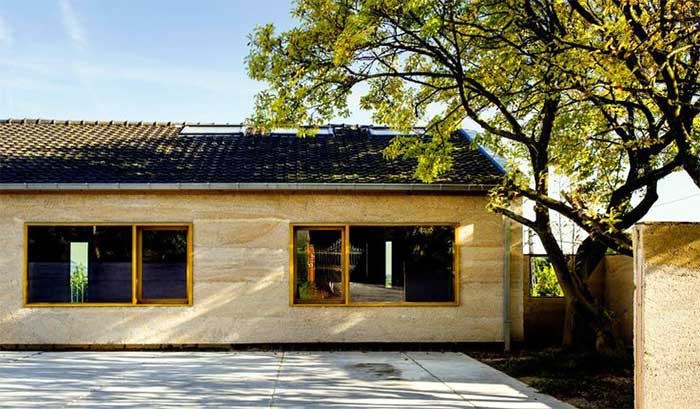
Rob: I think I know the answer to this one but I will ask it anyway. Do you plan to retire at some point in the future?
Graeme: I am not a big fan of the 21st century retirement model and I will most certainly never be embracing it. Every culture, prior to this has revered their elders. People previously looked forward to aging, as they gained a platform to share their wisdom with their families and fellow man. Now, the surgeon slows the dreaded aging process and our baby boomers gather together in hedonistic communities. Here, we waste many lifetimes of precious knowledge and experience, in pursuit of pleasure on the golf course, the bowling green and the card tables. I would never begrudge our grey nomads enjoying what they have worked so hard for, but I won’t be joining them. I will keep teaching, farming, writing, and nurturing my company, until my time is up.
